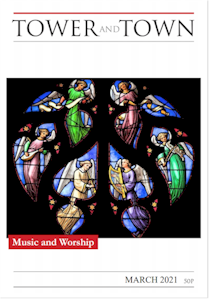

Tower and Town, March 2021 (view the full edition) (view the full edition)Spring SignalsWet February is not my favourite month, and windy March isnít much better, but the days get longer and there are moments when the air begins to smell different as the earth dries out, and we sense natureís gradual awakening. There are catkins and pussy willow in the hedgerows, and on sunny mornings brimstone butterflies flit by and maybe an orange tip too. From my neighbourís garden I begin hearing strange purring croaks in the twilight hours. I am told it is the male common frogs trying to attract the attention of females to their pond and intimidate other males. In early spring wild flowers add some much-needed colour to the drab countryside: snowdrops, celandines, violets and wood anemones. Soon kingcups begin to emerge in damp meadows while garish daffodils are everywhere in private and public gardens. Rarer and subtler is the wild daffodil, with narrow, grey-green leaves and a flower with pale yellow petals surrounding a darker yellow trumpet. They are shortish and form clumps in favoured localities in the Marlborough Downs and some local woods. Itís in March that hares go a bit loopy: the amorous buck seeks out the doe, and when he starts chasing her across fields and becomes too persistent she will turn around and fend him off in a fierce boxing match.  Some of our birds are just as daft: the male lapwing wobbles, zigzags, rolls and dives while calling to attract a potential mate, while in April a displaying snipe makes weird bleating sounds as it flies in a downward, swooping motion. Numbers of inland breeding lapwing and snipe have drastically declined in recent decades, while those of the stone curlew have increased. This special, rather secretive bird is a summer visitor to local downland sites, and the first few pairs already appear in March. February and March are the best months to see the scarce and elusive goshawk, which resembles an outsize sparrowhawk. Almost extinct as a breeding bird in the 19th century. there are now over 500 breeding birds in the UK, including a few in Wiltshire. Their display involves slow flapping circular soaring, sometimes followed by a dramatic plunge dive. These are some of the signs of natural renewal and regeneration, a source of reassurance in these uncertain times for the human race. Robin Nelson |